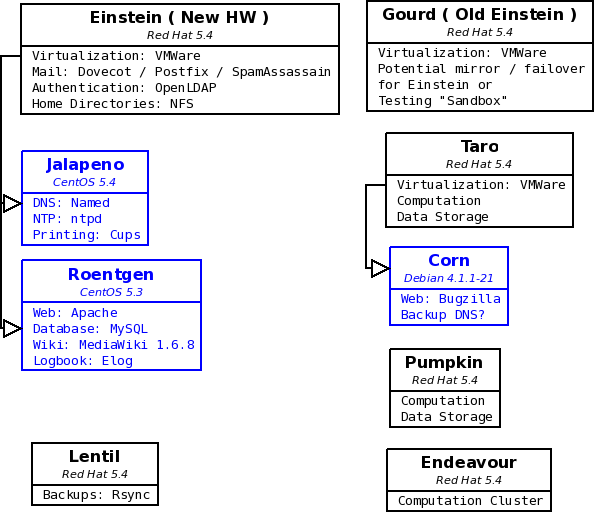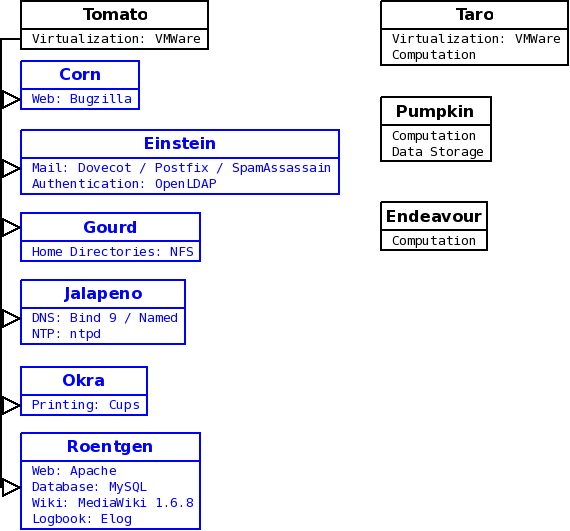Difference between revisions of "NPG Layout"
| Line 21: | Line 21: | ||
===Server Hardware=== | ===Server Hardware=== | ||
| + | |||
| + | '''[[Endeavour]]''' is our massive 26-node computing cluster. | ||
'''[[Gourd]]''' is a 2U rackmount server from [http://www.microway.com/ Microway] with two Quad-Core AMD Opteron processors and 32 GB of memory. It is the workhorse of the NPG server farm, hosting user's home folders as well as acting as the primary host for [[VMWare]] virtual machines. | '''[[Gourd]]''' is a 2U rackmount server from [http://www.microway.com/ Microway] with two Quad-Core AMD Opteron processors and 32 GB of memory. It is the workhorse of the NPG server farm, hosting user's home folders as well as acting as the primary host for [[VMWare]] virtual machines. | ||
'''[[Lentil]]''' is our backup server, and it is a custom built Dual-Core Pentium D machine with 2 GB of memory. | '''[[Lentil]]''' is our backup server, and it is a custom built Dual-Core Pentium D machine with 2 GB of memory. | ||
| + | |||
| + | '''[[Pumpkin]]''' is a Microway 5U rackmount server with four Dual-Core AMD Opteron processors and 32 GB of memory. It is used primarily for data storage and computation. | ||
'''[[Taro]]''' is a computation and data storage server with two Quad-Core Intel Xenon processors and 24 GB of memory. It also serves as a secondary host for virtual machines. | '''[[Taro]]''' is a computation and data storage server with two Quad-Core Intel Xenon processors and 24 GB of memory. It also serves as a secondary host for virtual machines. | ||
| − | '''[[ | + | '''[[Tomato]]''' was previously Einstein, and now is a secondary [[DNS]] server and [[VMWare]] host. |
| − | |||
| − | |||
= System Redesign = | = System Redesign = | ||
Revision as of 12:42, 14 June 2010
Current System Design
Systems Diagram
Here is a diagram of our current system layout.
Black Systems represent physical hardware.
Blue Systems represent Virtual Machines
Arrows indicate which system a Virtual Machine is running on. Other hosts with VMWare capability can be used to fill in for the main Virtualization server during downtime.
Operating System is listed in italics beneath each system's name
Services are listed in the second row of the diagram, followed by the name of the software used to provide that service.
System Descriptions
Brief descriptions of our computing systems. For more detailed information see the servers and workstations page.
Server Hardware
Endeavour is our massive 26-node computing cluster.
Gourd is a 2U rackmount server from Microway with two Quad-Core AMD Opteron processors and 32 GB of memory. It is the workhorse of the NPG server farm, hosting user's home folders as well as acting as the primary host for VMWare virtual machines.
Lentil is our backup server, and it is a custom built Dual-Core Pentium D machine with 2 GB of memory.
Pumpkin is a Microway 5U rackmount server with four Dual-Core AMD Opteron processors and 32 GB of memory. It is used primarily for data storage and computation.
Taro is a computation and data storage server with two Quad-Core Intel Xenon processors and 24 GB of memory. It also serves as a secondary host for virtual machines.
Tomato was previously Einstein, and now is a secondary DNS server and VMWare host.
System Redesign
These notes describe the migration from the old system layout with the original hardware Einstein to the current Gourd hardware / Einstein VM design.
First Proposed Redesign
This updated diagram incorporates Maurik's suggested changes:
Questions / Concerns
This design attempts to minimize the number of virtual machines which frees up a couple of host names. I made Corn a backup DNS server that would run on Taro because this is the best way to failover in case something happens with Jalapeno. Even if Einstein goes down entirely we'll at least have one DNS server still running.
Corn is running Debian and is designed to be a standalone Bugzilla appliance. It is not known whether this will make it difficult to add the DNS functionality ( it should be as simple as installing the service and copying the configuration from Jalapeno ). This needs to be investigated. An alternative is leaving Corn as a standalone and using the Okra virtual machine to provide printing as well as acting as a backup DNS.
It is not known yet whether the old Einstein will be usable as a mirror / failover for the new Einstein. This should be investigated. If it is, we should also investigate whether it will need a Red Hat license, or if CentOS will be sufficient.
Second Proposed Redesign
This design is deprecated, but left here for reference purposes.


